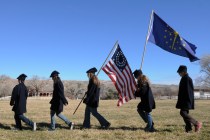Delamar ghost town offers glimpse into Nevada’s past
Spring green softens the stark stone walls, weathered timbers and rusted metal that mark the remains of Delamar, an infamous gold mining town that boomed in southeastern Nevada more than a century ago. At this season, colorful wildflowers vie for attention, creating splashes of color among the ruins scattered over rugged foothills about 150 miles from Las Vegas. The ghost town settles into the lightly wooded mountains south of U.S. 93 on the way to Caliente in Lincoln County.
Head north from Las Vegas on Interstate 15 to the U.S. 93 turnoff near Apex. Designated a scenic route, U.S. 93 passes the future development at Coyote Springs before it reaches pastoral Pahranagat Valley with its tranquil lakes and pastures dotted with cattle and horses on ranches near old Alamo.
At a major junction beyond Alamo, stay on U.S. 93 heading for Caliente. The road tops Paroc Summit and cuts across wide Delamar Valley toward Oak Springs Summit. Watch for the marked turn onto Delmar Road before you reach the wooded second summit.
Head south on this good graded road along a power line until it branches off east toward the ghost town. Follow this somewhat rougher side road 16 miles into the sage-covered foothills. An 8,000-foot peak tops the serrated Delmar Range, which is cut by many steep canyons.
A small, roofless stone building stands alone alongside the road near a short spur to the forlorn Delamar cemetery. Its boundaries marked by a wire fence, the cemetery contains a few headstones, monuments and ornate metal fences delineating some of the graves and family plots. Sadly, the boundary fence keeps out livestock, but not vandals.
Continue on the road, climbing over a hill for the first view of Delamar. Nothing but a mining town would be located at such a site. The road descends to wander past stone ruins, mill floor girders, mine dumps, open glory holes, scars of diggings and black tunnel mouths. The huge wooden beams supporting the floor of a large mill disintegrate just below the road, lying unprotected by walls or roof for many years. Because the wood shoring up Delamar's mine tunnels is just as old and dangerous, stay out of the tunnels and watch for open shafts as you explore.
Visitors today must use their imaginations to re-create the Delamar of yesteryear when it was home to 3,000 souls. Original buildings of canvas and wood succumbed to fires, the scourge of most early mining towns. When people rebuilt, they used stone, easily quarried in the area. A few wooded buildings arrived ready-made on skids from Pioche. Those that survived went back when Delamar declined.
Discoveries of gold-bearing rock in the early 1890s by Mormon farmers from Pahranagat Valley led to the establishment of the Ferguson mining district. A couple of rough camps soon rose from the sagebrush. In 1893, Montana investor Capt. John De Lamar bought up the existing properties. A new camp called Delamar supplanted the others when De La Mar began development in 1894.
Delamar always suffered from lack of water. Tiny springs nearby proved inadequate. A pipeline with several pumping stations brought water over the mountains from Meadow Valley to the east. It was barely enough for human needs, let alone fighting fires or settling the dust in the mines and mills.
Many who worked in Delamar paid the ultimate price for the lack of water. Delamar's gold occurred in silica-laden stone, which created a fine dust when crushed. Miners often developed silicosis, a dreaded lung disease. Delamar became infamous as a widow-maker. Nevertheless, the high wages attracted men from all over the region. Many went home to die in Utah, uncounted in the widow-maker's known toll.
Delamar ranked first in Nevada for production from 1895 to 1900.
Even after Tonopah and Goldfield boomed in the early 1900s, Delamar ranked just behind them. Delamar's boom days were over by 1909. All told, the widow-maker yielded $13.5 million, but the human cost remains incalculable.
Margo Bartlett Pesek's column appears on Sundays.

















